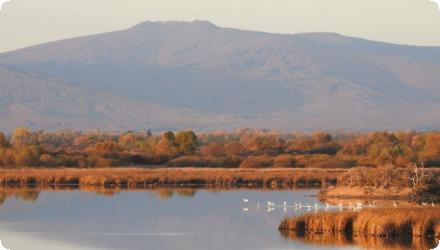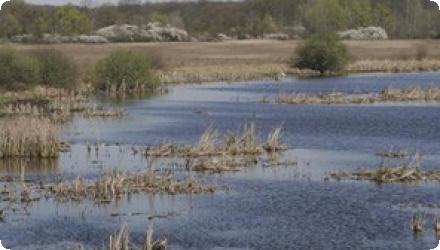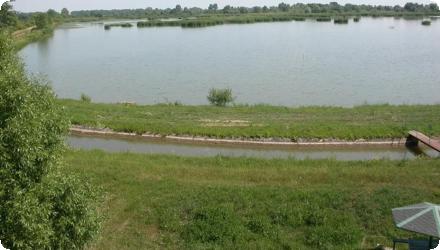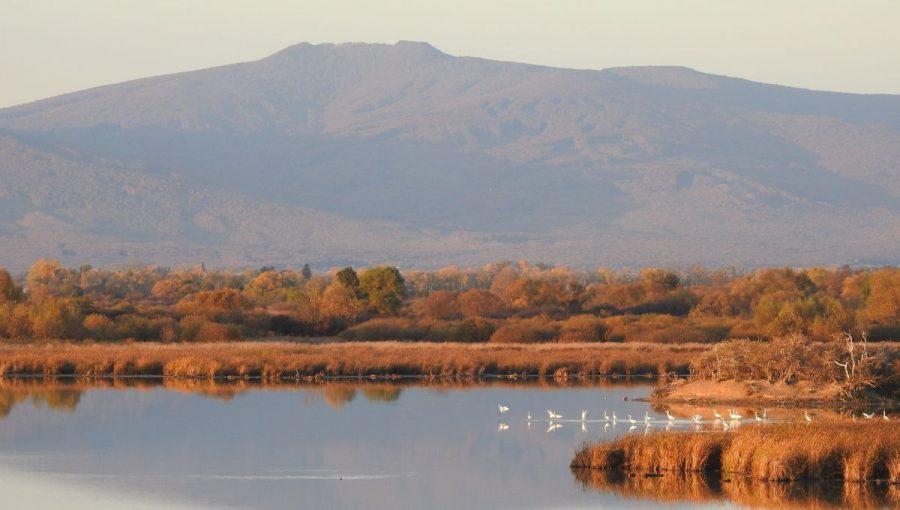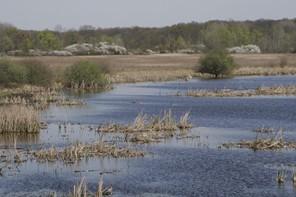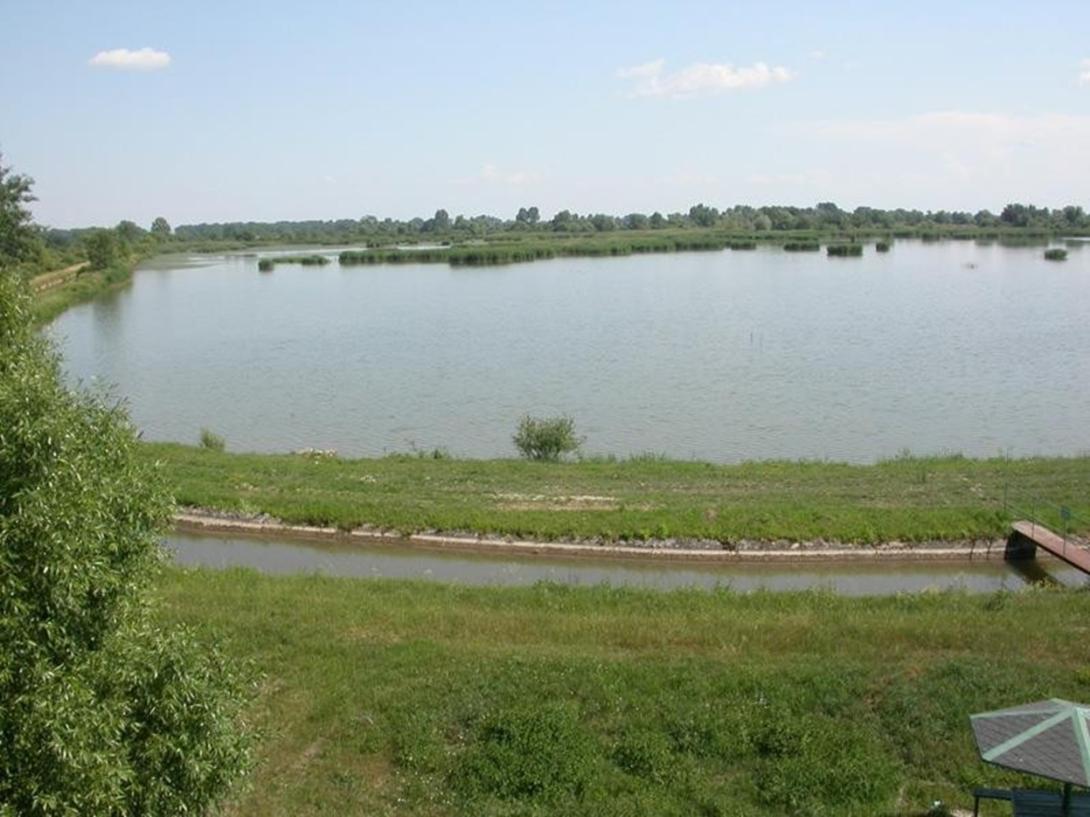Last update
2025
Summary
The action, led by the State Nature Conservancy of the Slovak Republic with NGO partners and funded by LIFE and national sources, set out to restore the favourable conservation status of breeding and migratory Birds/Habitats Directive species in the Senné (Senianske rybníky) and Medzibodrožie SPAs by improving key wetland habitats. Since then, conservation has continued under follow-on projects and plans. In Medzibodrožie, LIFE AYBOTCON (2011–2018) restored c.280 ha of water biotopes, created buffer zones, modified 1 770 m of power lines to reduce collisions, purchased land, and improved occurrences of bittern and ferruginous duck. In Senné, LIFE IPORSEN (2017–2027) focuses on hydrological restoration - repairing four sluice gates, 1.6 km of channels and 1 km of dykes, and reconnecting oxbow arms - alongside reedbed/grassland management, creation of nesting sites and small visitor infrastructure.
Both SPAs now have government-approved management plans for 2022–2051 that set long-term objectives, measures and indicative budgets for water-regime restoration and habitat management.
In 2023, IPORSEN works at Senné included repairing dikes and reconstructing the supply canal to secure water levels across the pond system.
Both SPAs now have government-approved management plans for 2022–2051 that set long-term objectives, measures and indicative budgets for water-regime restoration and habitat management.
In 2023, IPORSEN works at Senné included repairing dikes and reconstructing the supply canal to secure water levels across the pond system.
Position
Latitude
48.75445
Longitude
21.921
Project
NWRM
National Id
Slovakia_09
Installation date
2010-11
Implementation Status
Contact
Jovanka Ignjatovic, REC
RBD code
SK40000
Transboundary
0
Photo gallery
Location of the project
The project take place in the Canal O2, south from village Senné and canal K23 at the site Blatá in municipal area of Iňačovce, within Senné Special Protection Area (SPA), situated in districts Michalovce and Sobrance, in municipal areas of villages Senné, Iňačovce, Blatná Polianka, Blatné Remety and Hažín.
And in Ostrovik, near village Senné, in Medzibodrožie SPA, situated in Michalovce district, in Beša and Čičarovce municipal areas.
And in Ostrovik, near village Senné, in Medzibodrožie SPA, situated in Michalovce district, in Beša and Čičarovce municipal areas.
NUTS Code
SK04 - Východné Slovensko
Project's objectives
Creation of :
- 9 100 m2 of new breeding
- 21 700 m2 of feeding habitats in Senné SPA
- 400 m2 of new breeding and feeding habitats in Medzibodrožie SPA
Purchase of more than 55 ha plots tied to meadows and wetlands in Senné SPA
Restoration of more than 1500 ha of wet meadows
- 9 100 m2 of new breeding
- 21 700 m2 of feeding habitats in Senné SPA
- 400 m2 of new breeding and feeding habitats in Medzibodrožie SPA
Purchase of more than 55 ha plots tied to meadows and wetlands in Senné SPA
Restoration of more than 1500 ha of wet meadows
Involved Partners
| Authority type | Authority name | Role | Comments |
|---|---|---|---|
Climate zone
cool temperate dry
Temperature
8,4 °C
Precipitation
631
Annual rainfall range
600 - 900 mm
Runoff
189
Runoff coefficient
0,3
Runoff coefficient range
0.2 - 0.3
Runoff range
150 - 300 mm
Elevation range
116 m
Slope range
2-5%
Vegetation class
The whole area is characterized by a diverse mosaic of habitats – open waters, reed beds, meadows, oxbows, floodplain forests, marshes, fields, sand dunes and xerothermic habitats – and vegetation of floating, emerged and submerged water-plants. The fish-ponds are surrounded by wet meadows.
Water bodies: Ecological Status
Poor
Water bodies: Chemical Status
Failing to achieve good
Project scale
Meso
Project scale specification
Senné SPA:
Part of the SPA is a National Nature Reserve Senné fish ponds with area 213.3 ha and with a buffer zone 211,2 ha.
Medzibodrožie SPA:
The Latorica Protected Landscape Area is a part of the Medzibodrožie SPA (33754 ha). An axis of the area is the Latorica river, which together with the Laborec and Ondava rivers make up the Bodrog river. The spa-ce between flood-protection dykes of the Latorica river was designated as a Ramsar site (4358 ha).
Part of the SPA is a National Nature Reserve Senné fish ponds with area 213.3 ha and with a buffer zone 211,2 ha.
Medzibodrožie SPA:
The Latorica Protected Landscape Area is a part of the Medzibodrožie SPA (33754 ha). An axis of the area is the Latorica river, which together with the Laborec and Ondava rivers make up the Bodrog river. The spa-ce between flood-protection dykes of the Latorica river was designated as a Ramsar site (4358 ha).
Performance timescale
1 - 4 years
Project area
4571
Area subject to Land use change or Management/Practice change (ha)
213
Lifespan
50
Criterion species are bird species, which used as basis for identification and designation of SPAs. Different types of wetland habitats in Senné SPA and Medzibodrožie SPA through marshes, oxbows, wet meadows and fish-ponds with permanent water surface provide conditions for breeding and migration of several species of herons and related species, grebes, rails, ducks and geese, waders, raptor and passerine species tied with wetland habitats.
2088
In 70’ a fishpond-system has been built in the Senné depression. The system was divided into two parts: productive fishponds for intensive production of fish and one fishpond was devoted to nature protection. It has been declared as Natural Nature Reserve Senné fishponds for protection of waterfowl. A permanent water surface (600 ha of fishponds and 213 ha of the NNR) in Senné depression has become an important breeding site of waterfowl of international importance (today it is a Ramsar site, a Special Area of Conservation and a Special Protection Area). One of the factors threatening this site was a lack of water, evident mainly in summer time, leading in some cases even to drying up of the NNR.
Part of the Protected Bird Area Medzibodrožie has been already in year 1990 declared as Protected Landscape Area Latorica. It is a very diverse area, unique by a number of oxbows around river Latorica, by wet meadows, pastures and former pastures, floodplain forests, marshes, and also by arable land. The area is important for its diverse wild fauna and flora. It belongs to most important sites in Slovakia for several
threatened bird species, especially of waterfowl, but also for some other species, preferring dryer habitats, including sand dunes.
A majority of local population in area of the Senné depression and in Medzibodrožie is not aware of high natural value of the landscape, in which they live and of its importance for sustainable living in their regions. This factor, together with increasing negative impact of activities of some local stakeholders (commercial fishpond industry, hunting on protected bird species) on bird populations together with inadequate capacity of state institutions in nature protection to solve the problems lead to unfavorable status of target bird species in both SPAs.
Part of the Protected Bird Area Medzibodrožie has been already in year 1990 declared as Protected Landscape Area Latorica. It is a very diverse area, unique by a number of oxbows around river Latorica, by wet meadows, pastures and former pastures, floodplain forests, marshes, and also by arable land. The area is important for its diverse wild fauna and flora. It belongs to most important sites in Slovakia for several
threatened bird species, especially of waterfowl, but also for some other species, preferring dryer habitats, including sand dunes.
A majority of local population in area of the Senné depression and in Medzibodrožie is not aware of high natural value of the landscape, in which they live and of its importance for sustainable living in their regions. This factor, together with increasing negative impact of activities of some local stakeholders (commercial fishpond industry, hunting on protected bird species) on bird populations together with inadequate capacity of state institutions in nature protection to solve the problems lead to unfavorable status of target bird species in both SPAs.
Severe weather conditions and consequent heavy floods in 2010
Maintaining favorable habitats conditions for birds for birds in purchased land, wet meadows and wetlands
Total cost
€1,242,576
Costs total information
Infrastructure costs were incurred at 66.56 % compared to original budget. Discrepancy compared to original budget is caused by the fact that some infrastructure, notably water gates at Medzibodrozie project site, was financed through Norwegian/EHP Financial Mechanism and accordingly, it was not accounted to the present budget.
Non-recurring management activities in Medzibodrozie SPA were subject of Project modification and mostly were financed through the financial assistance from EEA/Norwegian Financial mechanism that the SNC received for implementing the project “Conservation of diversity of water birds at the Eastern Slovakian Lowland.
Non-recurring management activities in Medzibodrozie SPA were subject of Project modification and mostly were financed through the financial assistance from EEA/Norwegian Financial mechanism that the SNC received for implementing the project “Conservation of diversity of water birds at the Eastern Slovakian Lowland.
Costs investment
524930
Costs investment information
Includes: infrastructural costs and equipment costs
Costs capital
507646
Costs capital information
Includes: External assistance costs, direct personnel costs and Consumable materials
Costs land acquisition
210000
Costs land acquisition unit
€ (total value)
Costs land acquisition information
The targeted purchase of 50 hectares of wet meadows important for birds in Senne SPA was exceeded. Total of 54,3731 ha of land was purchased by SOS/BirdLife Slovakia at Ostrovik Meadows
Financing authorities
Type of funding
EU-funds: LIFE+
Type of funding
National funds
Compensations
1
Compensations basis information
In regard to the Pilot –aqua environmental scheme proposal for Senne Fish ponds that has been prepared and promoted, but not included into the Operational Program “Fisheries of the Slovak Republic 2007-2013”, Ministry of Environment suggested that 10% of funds that would be regulated by the Fisheries Operational Program be allocated for compensation payments.
Policy context
The Senné depression, as well as lowlands of Medzibodrožie were regularly flooded in the past on spring, economic activities were limited on catching of fish and pastoralism, arable land was situated only on better soils, mainly at slightly higher positions of the lowlands.
Often flooded lowlands were also habitats for waterfowl as long as the rivers were not regulated and lowlands were not drained by a network of melioration canals in the 1960-ies and 70-ies, which completely changed the whole landscape.
Oxbows were cut-off the rivers and in wet parts of the lowlands large tracts of land were dried up and groundwater levels dropped down. But recently it has become more and more visible, that most of these originally wet areas are not suitable for intensive agriculture because of permanently rewetted soils.
But a number of valuable wetlands and marshes, once being habitats for waterfowl, already disappeared by drying up in a consequence of unsuitable water regime. Meadows and pastures are wet only in the spring, but during summer they are already dry and a number of wetlands, once giving home to birds is slowly disappearing.
Often flooded lowlands were also habitats for waterfowl as long as the rivers were not regulated and lowlands were not drained by a network of melioration canals in the 1960-ies and 70-ies, which completely changed the whole landscape.
Oxbows were cut-off the rivers and in wet parts of the lowlands large tracts of land were dried up and groundwater levels dropped down. But recently it has become more and more visible, that most of these originally wet areas are not suitable for intensive agriculture because of permanently rewetted soils.
But a number of valuable wetlands and marshes, once being habitats for waterfowl, already disappeared by drying up in a consequence of unsuitable water regime. Meadows and pastures are wet only in the spring, but during summer they are already dry and a number of wetlands, once giving home to birds is slowly disappearing.
Community involvment
No
Design consultation activity
| Activity stage | Name | Key issues | Comments |
|---|
Policy target
| Target purpose |
|---|
|
Improved Biodiversity
|
Target Remarks
Biodiversity and gene-pool conservation in riparian areas
Regulation of hydrological cycle and water flow
improvement of breeding and feeding habitats for birds
increasing awareness of local people and environmental education
Regulation of hydrological cycle and water flow
improvement of breeding and feeding habitats for birds
increasing awareness of local people and environmental education
Policy pressure
| Pressure directive | Relevant pressure |
|---|---|
|
WFD identified pressure
|
4.1.5 Physical alteration of channel/bed/riparian area/shore – unknown
|
|
Other EU
|
Birds Directive 2009/147/EC Directive 79/409/EEC "Conservation of wild birds"
|
Policy impact
| Impact directive | Relevant impact |
|---|---|
|
WFD identified impact
|
Altered habitats due to hydrological changes
|
|
Other EU
|
Loss of natural habitats and wild fauna and flora
|
Requirement directive
| Requirement directive | Specification |
|---|---|
|
WFD-achievement of good ecological status
|
Elaborate Management plan for SPA Senne and water regime restorations in SPA Senne and Medzibodrožie
|
|
WFD-restoring a HMWB
|
Restored meadows and wetlands directly through implementing tailored restoration measures
|
Policy challenges requirements
Management plan for SPA Senne
Water regime restoration Plan for SPA Senne and Medzibodrožie
Environmental Impact Assessment Study
Water regime restoration Plan for SPA Senne and Medzibodrožie
Environmental Impact Assessment Study
Contractual arrangements
0
| Arrangement type | Responsibility | Role | Name | Comments |
|---|
Part of wider plan
0
Wider plan type
| Wider plan type | Wider plan focus | Name | Comments |
|---|
1. Installation of small infrastructures to improve control of the sites and allow regulated access of public: 5 towers for monitoring/bird-watching built in Senne SPA and 2 monitoring/visitors towers in Medzibodrozie SPA
2. Monitoring of restoration progress and development of habitats (performed by Daphne and by local expert Mr. Bogoly):
- Regular monitoring of ground water in dip-wells
- Habitat monitoring in project sites (2009 , 2010)
- Regular monitoring of dip-wells done (2010)
Monitoring of bird populations and assessment of conservation status in project sites:
- Regular monitoring of birds (2006, 2007, 2008)
- 3 monitoring camps organized during breeding season (04/2008, 05/2008, 06/2008)
- 1 monitoring camp in SPA Senne in 1st Q 2009 organized
- Regular monitoring of birds done in both project areas and 5 coordinated bird counts done in SPA Senne during 2010 (in March, April, May, June and November)
2. Monitoring of restoration progress and development of habitats (performed by Daphne and by local expert Mr. Bogoly):
- Regular monitoring of ground water in dip-wells
- Habitat monitoring in project sites (2009 , 2010)
- Regular monitoring of dip-wells done (2010)
Monitoring of bird populations and assessment of conservation status in project sites:
- Regular monitoring of birds (2006, 2007, 2008)
- 3 monitoring camps organized during breeding season (04/2008, 05/2008, 06/2008)
- 1 monitoring camp in SPA Senne in 1st Q 2009 organized
- Regular monitoring of birds done in both project areas and 5 coordinated bird counts done in SPA Senne during 2010 (in March, April, May, June and November)
Maintenance
BirdLife Slovakia will continue maintenance activities focused on preservation of reestablished natural conditions in the area, as favorable water regime on the restored meadows and wetlands by operation of water gates and sluices built at in SPAs.
Catchment outlet
Regular monitoring of ground water in 30 dip wells installed in the SPAs and birds (Standard ornithological methods)
Buffer belts around wetlands (AYBOTCON) socio-economics: improved recreational value; infrastructure (trails, towers) supporting local economy; potential employment; positive spillovers for private fish-culture
Ecotourism upgrade (2020–2023): “BirdTour” created a visitor centre at Senné, bike rental, a tower, campsite, and refreshed the nature trail.
Ecotourism upgrade (2020–2023): “BirdTour” created a visitor centre at Senné, bike rental, a tower, campsite, and refreshed the nature trail.
Presence of SPAs in vicinity of villages in combination with extensive tourist infrastructure established within a framework of the project and outstanding opportunities for birdwatching shall attract local and foreign visitors. Consequently, the local people can benefit indirectly through provision of services to tourist in villages.
Information on retained water
Senné (2020–2023): 1,690 m of dikes repaired/maintained; 2,170 m of supply/drain channels repaired or reopened; improved water regime over ~814 ha (entire pond system + Ostrovik meadow). Annual sluice manipulation now used across key sub-sites; a 600 m dike on Ostrovik rebuilt; some state parcels transferred to the nature agency to ease water management.
Medzibodrožie (2022–2023): gravity filling and targeted pumping improved biotopes on 29.22 ha; improved water regime on 264 ha; 955 m of old channels/oxbows restored/maintained; 20 localities (total 289 ha) benefited; breeding of both target species recorded. ~280 ha of water biotopes managed/restored; 4 ha buffer zones; 141 ha of wetlands restored; 1,770 m of power lines modified to reduce collisions; 54 ha land bought; water regimes restored on 65–75 ha; fish restocking; increases in localities with bittern & ferruginous duck by 2016–2018.
Medzibodrožie (2022–2023): gravity filling and targeted pumping improved biotopes on 29.22 ha; improved water regime on 264 ha; 955 m of old channels/oxbows restored/maintained; 20 localities (total 289 ha) benefited; breeding of both target species recorded. ~280 ha of water biotopes managed/restored; 4 ha buffer zones; 141 ha of wetlands restored; 1,770 m of power lines modified to reduce collisions; 54 ha land bought; water regimes restored on 65–75 ha; fish restocking; increases in localities with bittern & ferruginous duck by 2016–2018.
Information on increased water storage
704 hectares positively influenced by restored water regime
Information on runoff reduction
Approximately 990 ha of restored flooding regime
Water quality overall improvements
Not relevant for this application
Information on Water quality overall improvements
Not relevant for this application
Soil quality overall soil improvements
Not relevant for this application
Information on Soil quality overall soil improvements
Not relevant for this application
1
1 098 ha of habitats of Waterbirds improved by water regime. The improved water level affected bird habitats and populations including two species of European importance, the the common crane (Grus grus) and the white-tailed eagle (Haliaeetus albicilla), that started to breed for first time ever in the NNR.
Improved water level in the NNR positively affected bird habitats and populations including qualifying species of European concern, like Chlidonias hybridus, Nycticorax nycticorax, Egretta garzetta, Ardea purpurea, Circus aeruginosus, Ardea alba, Botaurus stellaris, Aythya nyroca, Phalacrocorax pygmaeus and
many other bird species, through suitable breeding and feeding habitats in NNR
Improved water level in the NNR positively affected bird habitats and populations including qualifying species of European concern, like Chlidonias hybridus, Nycticorax nycticorax, Egretta garzetta, Ardea purpurea, Circus aeruginosus, Ardea alba, Botaurus stellaris, Aythya nyroca, Phalacrocorax pygmaeus and
many other bird species, through suitable breeding and feeding habitats in NNR
Ecosystem impact climate regulation
Not relevant for the specific application
Information on Ecosystem impact climate regulation
Not relevant for this application
Ecosystem provisioning services
1
Information on Ecosystem provisioning services
Elaborated pilot aqua environmental scheme for protection of birds and its habitats in intensively managed fishponds.
Key lessons
- Importance of existing proper legal and financial instruments
- Good project implementation was achieved generally, through good co-operation and communication with local stakeholders established in both project areas.
- Especially good relationship was maintained with local villages, who were the project partners as well as with farmers, local schools, etc. Most of farmers/lands users supported key project activities, such as restoration of flooding regime at meadows and establishment of tourist infrastructure that was overall pilot one within the region.
- Good co-operation was also maintained with state water management agency “SVP” that was contracted for all the construction works related to restoration of dyke, water inlet and outlet in Senne NNR.
- Cooperation was not, however established with fish farming company “DONA”, that was expected to implement pilot aquaenvironmental scheme. When refusing cooperation, they gave reason of general insufficiency of compensation and incentives system for nature protection in Slovakia and consequent repeating economic loss of their company caused by birds feeding on fish from commercial fishponds.
- The process of implementation of the project was negatively influenced by several external factors including, inter alia, changes in land ownership in vicinity of project area within Medzibodrozie SPA in 2006 and severe weather conditions in 2010.
- Innovation and demonstration value of the project was in demonstrating approaches to nature conservation that are, so far, not common ones in Slovakia
- Needs for dissemination of project results, exchange of scientific expertizes and conservation experience with other practitioners / regions particularly in addressing opportunities and challenges characteristic for individual sites
- Lock in long-term governance: SPA management plans (2022–2051) and targeted land transfers to the conservation authority make adaptive water management easier.
- Align with agriculture/fishpond use: buffers and negotiated reed/Typha management reduce conflicts and nutrient loads; dialogue and enforcement remain necessary.
- Good project implementation was achieved generally, through good co-operation and communication with local stakeholders established in both project areas.
- Especially good relationship was maintained with local villages, who were the project partners as well as with farmers, local schools, etc. Most of farmers/lands users supported key project activities, such as restoration of flooding regime at meadows and establishment of tourist infrastructure that was overall pilot one within the region.
- Good co-operation was also maintained with state water management agency “SVP” that was contracted for all the construction works related to restoration of dyke, water inlet and outlet in Senne NNR.
- Cooperation was not, however established with fish farming company “DONA”, that was expected to implement pilot aquaenvironmental scheme. When refusing cooperation, they gave reason of general insufficiency of compensation and incentives system for nature protection in Slovakia and consequent repeating economic loss of their company caused by birds feeding on fish from commercial fishponds.
- The process of implementation of the project was negatively influenced by several external factors including, inter alia, changes in land ownership in vicinity of project area within Medzibodrozie SPA in 2006 and severe weather conditions in 2010.
- Innovation and demonstration value of the project was in demonstrating approaches to nature conservation that are, so far, not common ones in Slovakia
- Needs for dissemination of project results, exchange of scientific expertizes and conservation experience with other practitioners / regions particularly in addressing opportunities and challenges characteristic for individual sites
- Lock in long-term governance: SPA management plans (2022–2051) and targeted land transfers to the conservation authority make adaptive water management easier.
- Align with agriculture/fishpond use: buffers and negotiated reed/Typha management reduce conflicts and nutrient loads; dialogue and enforcement remain necessary.
Success factor(s)
| Success factor type | Success factor role | Comments | Order |
|---|---|---|---|
|
Attitude of decision makers
|
main factor
|
<p>support provided by decision makers during the preparation and implementation phases of the project</p>
|
1
|
|
Attitude of the public
|
main factor
|
<p>local population involved as project partners as well as farmers, local schools, etc. Most of farmers/lands users supported key project activities, such as restoration of flooding regime at meadows and establishment of tourist infrastructure that was overall pilot one within the region.</p>
|
2
|
|
Attitude of relevant stakeholders
|
main factor
|
<p>Good project implementation was achieved generally, through Good co-operation and communication with local stakeholders established in both project areas.</p>
|
3
|
|
Communication activities
|
main factor
|
<p>Number of dissemination acttions concerning project results, exchange of scientific expertizes and conservation experience with other practitioners / regions particularly in addressing opportunities and challenges characteristic for individual sites</p>
|
4
|
Driver
| Driver type | Driver role | Comments | Order |
|---|---|---|---|
|
Balancing different objectives
|
main driver
|
in relation to environmental and agro-fishinf concerns
|
1
|
|
Availability of subsidies
|
secondary driver
|
2
|
Flexibility adaptability
Adaptation to changing hydrological and habitat conditions have been achieved by a width range of structures reflecting surface, soil and geological conditions that are flexible concerning operation and further improvement of hydraulic conditions
Transferability
The project included numerous activities with reliability potential for the protection and management of other SPAs in Slovakia or for nature conservation approaches in general, as Management plan for Senne SPA, Land purchase for conservation objectives
Bird watching infrastructure in Senne SPA was a pilot infrastructure of this kind in Slovakia. It has huge reliability potential. Already in the Project span, the infrastructure was replicated in Medzibodrozie SPA within a framework of the project “Conservation of Diversity of Waterbirds and their Habitats in Eastern Slovakian Lowland “supported from EEA /Norwegian Financial Mechanism
Bird watching infrastructure in Senne SPA was a pilot infrastructure of this kind in Slovakia. It has huge reliability potential. Already in the Project span, the infrastructure was replicated in Medzibodrozie SPA within a framework of the project “Conservation of Diversity of Waterbirds and their Habitats in Eastern Slovakian Lowland “supported from EEA /Norwegian Financial Mechanism
Basin characteristics influence
Both project sites are typical lowland habitats. High density of oxbows, shallow wetlands, canals and alluvial meadows.
English
